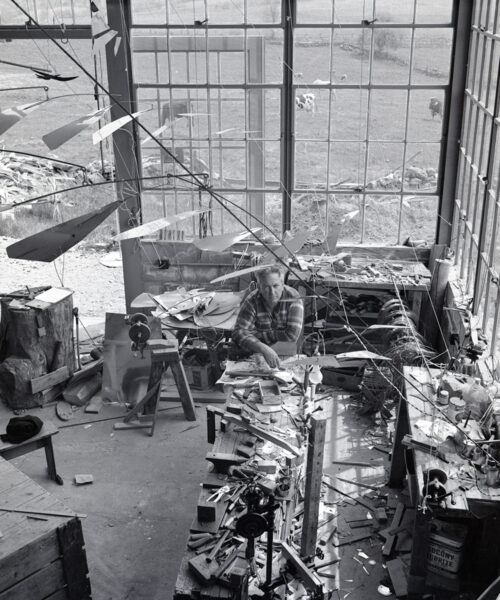Alexander Calder: Dynamic in Life and Art
By Clementina Verge
Among the most prolific 20th century artists, Alexander “Sandy” Calder created kinetic sculptures—mobiles featuring wire-connected forms that dazzle in midair—that have attracted worldwide acclaim. Most were made in Roxbury: Calder was among the first artists to arrive in 1933, seeking tranquility and privacy from increasingly-bustling cities like New York and Paris.
The Painter Hill Road farmhouse became a cultural and social hub for avant-garde ideas and lavish parties that included neighbors Hart Crane and Arthur Miller.
Most important, the home—now owned by the Calder Foundation—provided space for creative endeavors. In a studio he converted from an ice house, and later, in a larger one he built on the foundation of an old dairy barn, Calder worked tirelessly for more than four decades.
“He had the work ethic of a blue-collar steel worker—his hands were like rocks to prove it,” reminisces renowned Bantam potter Guy Wolff, whose connection to Calder was lifelong.
In 1953, while Calder and his wife Louisa spent a year in Provence, close friend Robert Jay Wolff and his pregnant wife were chosen to enjoy an extended country stay.
“I was almost born in the Calder house,” laughs Wolff, who acquired fond childhood memories in the “happy and tremendously beautiful” home “filled with music [and] dancing.”
Born in 1898 in Philadelphia—where a full-scale space dedicated to him is scheduled to open in 2025—Calder studied painting in New York City; later, in Paris, he instituted his radical Cirque Calder, an acclaimed one-man performance simulating a complete circus show.
“He would be on his knees, doing manipulations and yelling in French in his raspy voice, pretending to be a ringmaster. Louisa played the accordion,” Wolff reminisces. “It was fantastic. It was special. He was special. He never stopped.”
The same circus-theme initially captivated notable sculptor and art professor Mark Mennin.
“I was spoon-fed art history growing up in New York with two creative parents,” remembers Mennin, who resides and sculpts granite architectural works in Bethlehem. “Calder’s Circus was front and center at the Whitney [Museum of American Art], so that’s tattooed in the psyche as much as any of his works.”
Then eight-year-old Mennin was equally struck by the drama and the “defiance of gravity.”
With his ingenuity, Calder “changed the rules of what sculpture is/can be as early as the 1920s…[which] led him to real serious vanguard public art,” Mennin remarks.
Upon his death in 1976, Calder left more than 22,000 pieces in various mediums, including jewelry and impressive stabiles; the 50-foot Stegosaurus in Hartford is among the grandest, along with La Grande Vitesse, which Mennin recently admired in Michigan.
“It’s brilliantly sited,” he notes. “It’s participatory and interactive. You can walk in and out of it; there’s architectural logic to the procession through it and its scale is heroic.”
Ultimately, almost 47 years after his death, Calder’s legacy surpasses the tangible.
“Life in France and early exposure to surrealists reinforced his tendency to be a bricoleur, to get rid of the high drama of the academic figure,” Mennin explains. “He became a courier between European and American ideas and ideals, and inspires one to strive for a completeness in accomplishments over time.”
Though Mennin’s works “are bound to the earth by gravity” and Wolff creates mostly clay pottery, Calder’s integrity and passion impacted both.
“The people who find their truth and live it for a lifetime are most inspiring,” Wolff reflects. “There are those whose light doesn’t fade, but in fact gets brighter. Sandy was like that. Very much non-self-assuming, he just got bigger and bigger, and was an exceptional, generous human being.” —calder.org
















